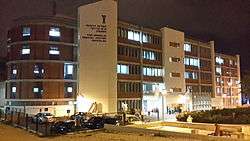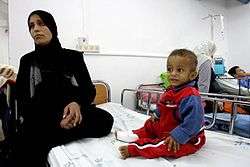Barzilai Medical Center
Barzilai Medical Center (Hebrew: מרכז רפואי ברזילי, Merkaz Refu'i Barzilai; Arabic: مركز برزيلاي الطبي) is a 617-bed hospital in Ashkelon in southern Israel. The hospital serves a population of 500,000, including a large number of Ethiopian and Russian immigrants, and has more than 100,000 admissions annually. Situated six miles from Gaza, it has been the target of numerous Qassam and Grad rocket attacks, sometimes as many as 140 in one weekend. The hospital plays a vital role in treating wounded soldiers and terror victims.[1] A Muslim holy site, Mashhad al-Husayn, recognized by the Ashkelon Municipality,[2]:214 was built in 2000 within the Hospital premises.
| Barzilai Medical Center | |
|---|---|
| |
Barzilai Medical Center | |

| |
| Geography | |
| Location | Ha-Histadrut, Ashkelon, Israel |
| Coordinates | 31°39′43″N 34°33′35″E |
| Services | |
| Beds | 617 |
| History | |
| Former name(s) | Ashkelon Hospital |
| Opened | July, 1961 |
| Links | |
| Website | bmc |
| Lists | Hospitals in Israel |
History

The hospital opened in July 1961, and was initially named Ashkelon Hospital. Construction was financed by the Ministry of Health with the assistance of the South African Zionist Federation, the Ashkelon municipality and Mifal HaPayis. The building was designed by the architect David Anatol Brutzkus, covering an area of 8,000m². In 1971, it was renamed after Minister of Health Yisrael Barzilai, who had laid the cornerstone of the building in the early 1960s,[3] and who had died the previous year.

Plans to build a new rocket and missile-proof emergency room for the hospital in 2010 were hampered by ultra-orthodox protests sparked by the discovery of human remains in an ancient burial ground unearthed during construction activities.[4]
Landmarks
Ras Al Husayn

A section of the grounds of the hospital is believed by some Shia Muslims to have been the burial place of the head of Husayn ibn Ali (Arabic: رَأس ٱلحُسَين, romanized: Rās al-Ḥusayn), a grandson of Muhammad. It was secretly moved by the Abbasids from its original burial site at The Great Mosque of Damascus. In the 11th century, Badr al-Jamali discovered the location and built a shrine (Arabic: مشْهد ٱلنَبِي ٱلحُسَين, romanized: Mäšhäď al-Nabī al-Ḥusyan, lit. 'Mausoleum of our Lord Husayn')[5] at the direction of the Fatimid Imam-Caliph, Ma'ad al-Mustansir. The shrine has since been a pilgrimage site for Shi'a Muslims and historically also Palestinian Sunnis.[2]:185-186[6][7]

In July 1950 the multi-storey structure was destroyed by Israel Defense Forces under instructions from Moshe Dayan.[2]:205-206[8] Around 2000, a marble platform was installed at the site by Mohammed Burhanuddin,[6][9][8][10] the 52nd Da'i al-Mutlaq of the Dawoodi Bohras, an Ismaili sect of predominantly Gujarati descent, who continue to visit Ashkelon despite resulting complications in travelling to other Muslim nations.[2]:214[7]
References
| Wikimedia Commons has media related to Barzilai Hospital. |
- "Steady rain of missiles strains Israeli hospital". NjJewishNews.com. New Jersey Jewish News. 8 April 2008. Archived from the original on 2011-07-22.CS1 maint: unfit url (link)
- Talmon-Heller, Daniella; Kedar, Benjamin; Reiter, Yitzhak (Jan 2016). "Vicissitudes of a Holy Place: Construction, Destruction and Commemoration of Mashhad Ḥusayn in Ascalon" (PDF). Der Islam: 11–13, 28–34. doi:10.1515/islam-2016-0008. Archived from the original on 12 May 2020.
- About The Barzilai Medical Center Archived July 28, 2014, at the Wayback Machine Barzilai Medical Center
- "Don't budge Barzilai bones". The Jerusalem Post. 18 March 2010. ISSN 0021-597X. Archived from the original on 3 Jan 2018.
- Michael Press (March 2014). "Hussein's Head and Importance of Cultural Heritage". American School of Oriental Research. Archived from the original on 17 May 2020. Retrieved 17 May 2020.
- Rami Amichay (9 Feb 2015). "Prophet's grandson, Hussein, honored on the grounds of an Israeli hospital". Reuters. Archived from the original on 12 May 2020. Retrieved 12 May 2020.
- "أتباع البهرة الشيعية يذرفون الدمع على قبر للحسين في عسقلان" [Shi'a Bohra followers shed tears at Hussein's grave in Ashkelon] (in Arabic) (9825). 11 Feb 2015. p. 20. ISSN 0140-010X. Archived from the original on 31 May 2020. Retrieved 31 May 2020 – via alarab.co.uk.
- History Erased Haaretz, 5 July 2007
- Sacred surprise behind Israeli hospital Los Angeles Times, 21 May 2008
- "Archeology for Everyone". Municipality of Ashkelon. Archived from the original on 12 May 2020. Retrieved 12 May 2020.